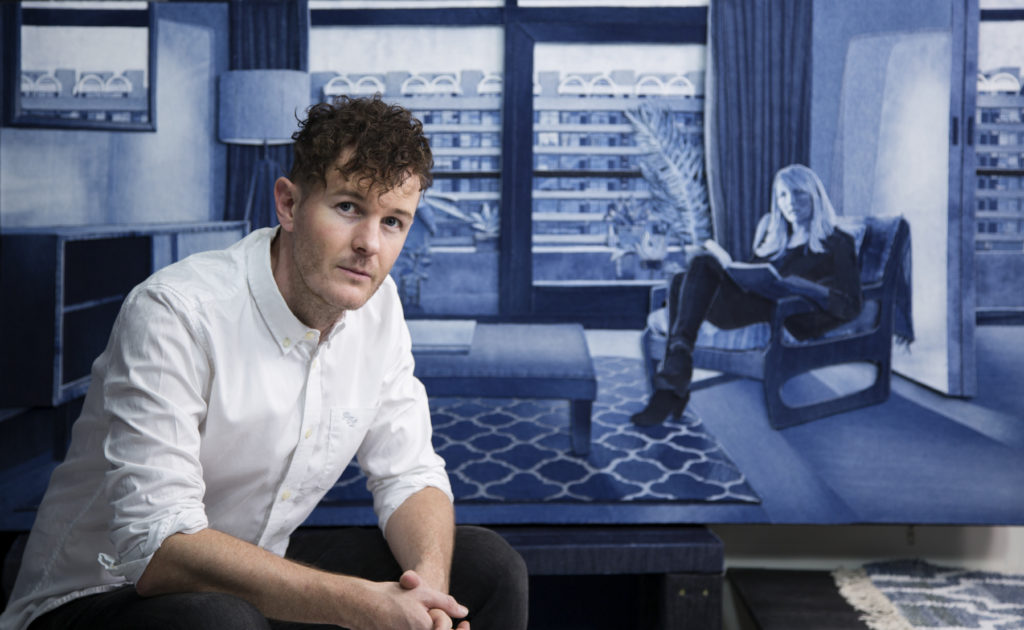
Artist Ian Berry Turns Old Denim Into New Art
For Ian Berry, a photo is worth a thousand layers of denim.
The British artist has made a name for himself by creating works of art made solely out of cut up old blue jeans. And don’t think this is abstract art with indistinct shapes of denim pieces piled among one another—no, Berry’s work depicts landscapes and portraits, all in painstaking denim detail.
Using layer on layer of all manner of denim hues and washes and patterns, Berry creates works of art that appear, at first blush, much like a photo-realistic painting. From subway scenes to cityscapes and a woman in bed swathed a denim comforter, Berry gets the shading and depth so right that even under-eye shadows are visible in the creations he creates.
Dubbed the “Master of Denim,” the “Jean Genie” and “Jeanius,” it’s clear to most that Berry sees the world through denim colored glasses. Ian is a dedicated artist who was actually named as a “Top 30 Artist Under 30 in the World” by Art Business News.
Carved in Blue caught up with the artist to get the scoop on this unusual—but strikingly beautiful—medium of expression.
Carved in Blue: When did you know you wanted to be an artist?
Ian: I was a young kid, I loved art and remember going to a David Hockney show in Bradford, the next city to where I grew up and was so inspired. However, being from a northern family in England, I listened to the people who said art isn’t a career and all that nonsense. I ended up working in advertising as an Art Director. I had come up with this idea before doing that though, and was doing it on the side, and then after a few years it turned into the thing that took over my life. It’s your name you are putting out there, so you work your ass off everyday, grateful that you are making your living and life from your art. I was always wanting to create things and so grateful that I got back into art, through the back door.
Carved in Blue: We’d love to hear, in your words, how you’d describe using your medium, methods and inspiration?
Ian: I make all my work out of only denim jeans, nothing else. No paint, No bleach.
Only using the washes with the varying tones of indigo within each cut piece, layering up the denim to make a three dimensional piece that when you stand back, create an almost photorealistic piece. I make both scenes and sometimes portraits. The latter can often look like an oil painting sing pallet knives.
Carved in Blue: What made you decide to use denim?
Ian: At first it was just the simple observation, seeing the old jeans I used to wear piled up at my childhood home. I decided to use the contrasting shades to make some simple artworks, but then while using it, it made me think of my own connection to denim. It was the only material I felt comfortable in and I transferred that to my work. Then I noticed other people’s reaction to denim and I feel there is something that draws them in, and that’s the denim. It’s so democratic and people seem to find a connection with it. Often I’m making familiar scenes, things that people may pass every day but take for granted, with denim, that is basically a default uniform in the city and by combining the two—they see something a new.
Carved in Blue: How many pieces of art can you produce in a year?
Ian: This is by far my biggest constraint; I can’t make them fast enough. I end up doing only a single figure percentage of the shows I could have done. And my problem is really, you need to see my work in real life, to get it. Reproduced it just doesn’t come out the same. With many layers of denim, and the blue colours hard to replicate, the reaction is chalk and cheese to that of someone in person to that online or to a magazine. I could work simply, but I choose to really push the technique and make the best work I can, this, sadly, can take weeks or months for each piece.
Carved in Blue: Do you view traditional denim design as art?
Ian: After meeting many of the people that make denim jeans, yes, for sure. I often say in my work I am just the final artist in the process as without what happens before, I cannot make my art. I met Moreno De Angelis at Iskoteca and he showed me many different laundry techniques, which, for me, is part of an art process, especially what he was showing me. He’s a genius. They say that 40 pairs of hands touch a pair of jeans before we get them, and I often think of them when I am working. Of course there are many sectors in the denim industry and it is exciting now to see many of the artisan denim brands popping up. And, of course to many people I now meet—denim is their art totally. I can’t claim to be a true denim head – but I am fascinated by those who are, but for me the use of denim is all about: it is for everyone and the material of our time, and our contemporary life is what I portray, so for me its perfect.
Carved in Blue: Where do you get your denim fabrics?
Ian: First it was my own, then my friends’, then their friends’. I would then scour charity stores and vintage shops, and sometimes if I loved the wash in the denim I would get pairs, which were never worn from a shop. Now, however, I have been very lucky to receive many pairs from Pepe Jeans London. The last four or more years they have been sending me pairs, and its great as you get used to them and they have really good washes and deep dark indigo colours. I’m not ashamed to say it has really improved my work working with the denim they send.
Carved in Blue: What’s your favorite work that you made?
Ian: It’s hard to say a favorite, and you really shouldn’t. But the best body of work that I have done is Behind Closed Doors, both technically and also conceptual it was more challenging. While a bit more challenging than city scenes, people really reacted to them, and many saw themselves in them. I found that quite powerful.

Carved in Blue: Who are some notable fans of your work?
Ian: Well while you can name drop I don’t particularly like it. I respect the people a great deal but their opinion is no more valid than many other people. I take as much pleasure out of an unknown but respected art buyers, than a ‘big’ name. On the same note, I have actually just been saying how I am so touched when I do shows and art fairs where there are so many different pieces under a roof, I find the cleaners getting other cleaners to come and look at the work. Like denim, art should be for everyone. My biggest pleasure, to be honest, is when kids get excited to see it. It takes me back to when I was a kid…wanting to create and be inspired.
Carved in Blue: Which city is most inspiring to you?
Ian: Of course it must be London. It’s the place I love and most of my work is inspired by. That said I do love to travel and see other places, especially when doing shows abroad, you get to spend more time with the locals. I love cities, and I’m inspired by them. I love the non-tourist areas, the hidden gems and the places the locals go. For me, it’s the many layers of urban life that interest me—and it’s more often than not a place that is a melting pot of interesting people. While denim is a very rural fabric from its origins, I see it now as a very urban fabric, again, the perfect material for me to portray urban contemporary living.
Carved in Blue: What do you think the denim industry needs?
Ian: People often think I am a denim “geek’” or fanatic. I’m not in the same way as many. I’m also not as clued up on the ins and out of the industry as some would think. So in knowing what it needs, I don’t fully know from a really great insight point of view. That said, I really do think that much of the good work some people are putting into sustainability is important. I am fully aware of the dualities of denim, and it saddens me to see some places in China and India where there is so much pollution. From an art point of view as well as denim, I really am interested in the combination between the laser machines and laundry techniques.
Carved in Blue: What does Carved in Blue mean to you?
Ian: The Carved in Blue community is great as it gives another opportunity to celebrate this community and share positive stories about it – bringing more people together. As someone who feels very much on the edge of the denim industry (as I’m doing something different to others pulling apart the denim not putting it together) it is good to find out what is going on and find out many new things.
I started my journey with very little knowledge of the denim industry and community. For me I loved denim, but also loved its universal appeal and the democratic way most people enjoyed it, without needing to be an expert in it. But as time has gone on it has been great to find out so much more about it ( even if often I feel the more l learn the more I feel I don’t know)
The one thing I have noticed, from the outside, is how so many people in the industry are supportive of others, and friends with others no matter which brand they are from.






